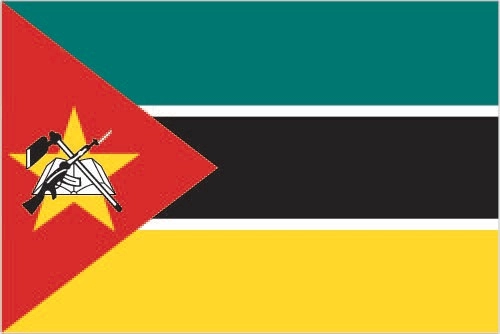
Mozambique
Country Flag Details
three equal horizontal bands of green (top), black, and yellow with a red isosceles triangle based on the hoist side; the black band is edged in white; centered in the triangle is a yellow five-pointed star bearing a crossed rifle and hoe in black superimposed on an open white book; green represents the riches of the land, white peace, black the African continent, yellow the country’s minerals, and red the struggle for independence; the rifle symbolizes defense and vigilance, the hoe refers to the country’s agriculture, the open book stresses the importance of education, and the star represents Marxism and internationalism
note: one of only two national flags featuring a firearm, the other is Guatemala.
Background
Mozambique ended almost five centuries as a Portuguese colony when it gained independence in 1975. Large-scale emigration, economic dependence on South Africa, a severe drought, and a prolonged civil war hindered the country’s development until the mid-1990s.

Geography
Area
total : 799,380 sq km
land: 786,380 sq km
water: 13,000 sq km
Climate
tropical to subtropical
Natural resources
coal, titanium, natural gas, hydropower, tantalum, graphite
People and Society
Population
total: 33,350,954
Ethnic groups
African 99% (Makhuwa, Tsonga, Lomwe, Sena, and others), Mestizo 0.8%, other (includes European, Indian, Pakistani, Chinese) 0.2% (2017 est.)
Languages
Makhuwa 26.1%, Portuguese (official) 16.6%, Tsonga 8.6%, Nyanja 8.1, Sena 7.1%, Lomwe 7.1%, Chuwabo 4.7%, Ndau 3.8%, Tswa 3.8%, other Mozambican languages 11.8%, other 0.5%, unspecified 1.8% (2017 est.)
Religions
Roman Catholic 27.2%, Muslim 18.9%, Zionist Christian 15.6%, Evangelical/Pentecostal 15.3%, Anglican 1.7%, other 4.8%, none 13.9%, unspecified 2.5% (2017 est.)
Population growth rate
2.54% (2024 est.)
Government
Government type
presidential republic
Capital name: Maputo
Executive branch
chief of state: President Daniel Francisco CHAPO (since 15 January 2025)
head of government: Prime Minister Maria Benvinda Delfina LEVI (since 17 January 2025)
Economy
Economic overview
low-income East African economy; subsistence farming dominates labor force; return to growth led by agriculture and extractive industries; Islamist insurgency threatens natural gas projects in north; ongoing foreign debt restructuring and resolution under IMF Highly Indebted Poor Countries (HIPC) initiative
Real GDP (purchasing power parity)
$50.844 billion (2023 est.)
$48.222 billion (2022 est.)
$46.206 billion (2021 est.)
Real GDP per capita
$1,500 (2023 est.)
$1,500 (2022 est.)
$1,500 (2021 est.)
Exports
$9.289 billion (2023 est.)
$9.409 billion (2022 est.)
$6.526 billion (2021 est.)
Exports – partners
India 18%, China 13%, South Africa 9%, UAE 6%, Thailand 4% (2023)
Exports – commodities
coal, natural gas, aluminum, gold, precious stones (2023)
Imports
$11.18 billion (2023 est.)
$15.932 billion (2022 est.)
$10.534 billion (2021 est.)
Imports – partners
South Africa 34%, China 14%, India 13%, UAE 6%, Singapore 3% (2023)
Imports – commodities
refined petroleum, chromium ore, iron alloys, iron ore, palm oil (2023)

Export structure by product group in 2023 (% of total exports) (UNCTAD)
The export structure of a country encompasses the variety, composition, and monetary value of its goods and services traded on the international market, thus providing vital insights into the nation’s economic vitality, competitive landscape, and developmental phase. In Mozambique, the export structure is significantly dependent on natural resources, agriculture, and manufacturing, with a pronounced emphasis on raw materials and semi-processed goods. The country is richly endowed with considerable mineral wealth, abundant energy resources, and substantial agricultural potential, which together position exports as a crucial pillar of its economic framework, driving growth and fostering opportunities for development in various sectors.
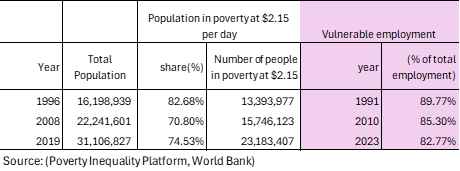
Poverty and vulnerable employment in Mozambique
In 2023, a staggering 83 percent of Mozambique’s workforce was categorized as vulnerable employment, characterized by insecure job conditions, meager wages, and insufficient social protections such as health insurance, pensions, or labor rights. This includes own-account workers like street vendors and small-scale farmers, as well as contributing family members who engage in family businesses without formal compensation. These roles are predominantly informal and precarious, rendering workers particularly susceptible to economic disruptions, exploitation, and poverty. The adverse effects of this type of employment extend beyond individual workers, impacting families and communities, and fostering entrenched cycles of hardship that are challenging to overcome.
Understanding poverty level significance at $ 2.15 per day
In 2019, a significant 75 percent of Mozambique’s population lived in poverty at $2.15 per day. The poverty level at $2.15 per day (measured in 2017 purchasing power parity, or PPP) is a key global benchmark used by the World Bank to define extreme poverty in low-income countries. It indicates:
1. Basic Survival Threshold
• People living below $2.15 per day struggle to afford essential needs such as food, clean water, shelter, healthcare, and education.
2. Economic Underdevelopment
• A high percentage of a country’s population living below this threshold suggests low economic productivity, high unemployment, and weak social safety nets.
3. Inequality and Social Vulnerability
• It reflects deep income inequality and a lack of access to opportunities for upward mobility.
• People in this category are more vulnerable to shocks like food price increases, climate disasters, or health crises.
4. Policy Challenges
• Governments need targeted interventions such as social welfare programs, job creation, and improved access to education and healthcare to reduce poverty.
A country's export structure is a reflection of its level of development and productive capacities
The export structure of a country refers to the composition, diversity, and value of the goods and services it sells to other countries. It provides key insights into the country’s economic health, competitiveness, and level of development. Productive capacities of a country refer to its ability to produce goods and services efficiently and sustainably over time. These capacities are shaped by various factors, including human capital, natural resources, infrastructure, private sector, development, technology & innovation, institutions & governance, financial systems trade & market access (UNCTAD).
Here’s what the export structure and productive capacities of a country typically indicate:
- Level of Economic Development
- Developed economies usually export high-value manufactured goods, technology, and services.
- Developing economies often rely on raw materials, agricultural products, or low-value manufactured goods.
- Industrial and Sectoral Strengths
- A strong presence of high-tech or industrial goods (e.g., machinery, electronics) suggests a well-developed manufacturing sector.
- A dominance of commodities (e.g., oil, minerals, agricultural products) indicates reliance on natural resources.
- Export Diversification
- A diverse export base (multiple industries) makes a country’s economy more stable and resilient to global price shocks.
- A concentrated export base (few key products) makes it vulnerable to market fluctuations.
- Trade Partnerships and Dependence
- If exports are heavily dependent on a single country or region, the economy is more exposed to geopolitical and trade risks.
- A wide range of trading partners indicates stronger global integration.
- Competitiveness and Value Addition
- Exporting mainly raw materials (e.g., crude oil instead of refined petroleum) suggests limited industrial processing capacity.
- A high share of finished and high-tech goods suggests strong value addition and competitiveness.
Mozambique-Sanitation
Mozambique – Proportion of population served with at least basic sanitation
In 2022, proportion of population served with at least basic sanitation for Mozambique was 37.4 %. Proportion of population served with at least basic sanitation of Mozambique increased from 10.2 % in 2003 to 37.4 % in 2022 an absolute change of 27.2 percentage points (pp) between 2000 and 2022.
Mozambique- Proportion of urban population served with at least basic sanitation
In 2022, proportion of urban population served with at least basic sanitation for Mozambique was 61.3 %. Proportion of urban population served with at least basic sanitation of Mozambique increased from 30.9 % in 2000 to 61.3 % in 2022 an absolute of change 30.4 pp between 2000 and 2022.
Mozambique – Proportion of rural population served with at least basic sanitation
In 2022, proportion of rural population served with at least basic sanitation for Mozambique was 22.6 %. Proportion of rural population served with at least basic sanitation of Mozambique increased from 1.7 % in 2000 to 22.6 % in 2022 an absolute change of 20.9 pp between 2000 and 2022.
Mozambique – Proportion of population served with at least basic sanitation: A Global Perspective
Mozambique is facing a critical sanitation crisis that poses a significant public health threat. We must unite to guarantee access to safe sanitation, a fundamental human right, for all. In 2022, around 21 million people, nearly 63 percent of Mozambique’s population, experienced the harsh realities of inadequate sanitation infrastructure, contrasting sharply with countries like Vietnam, China, and Thailand, where only 8 percent, 5 percent, and 1 percent of their populations lacked adequate sanitation services. With the global average at about 6 percent, it is clear that we urgently need cooperative efforts to enhance sanitation access in marginalized areas of Sub-Saharan Africa.
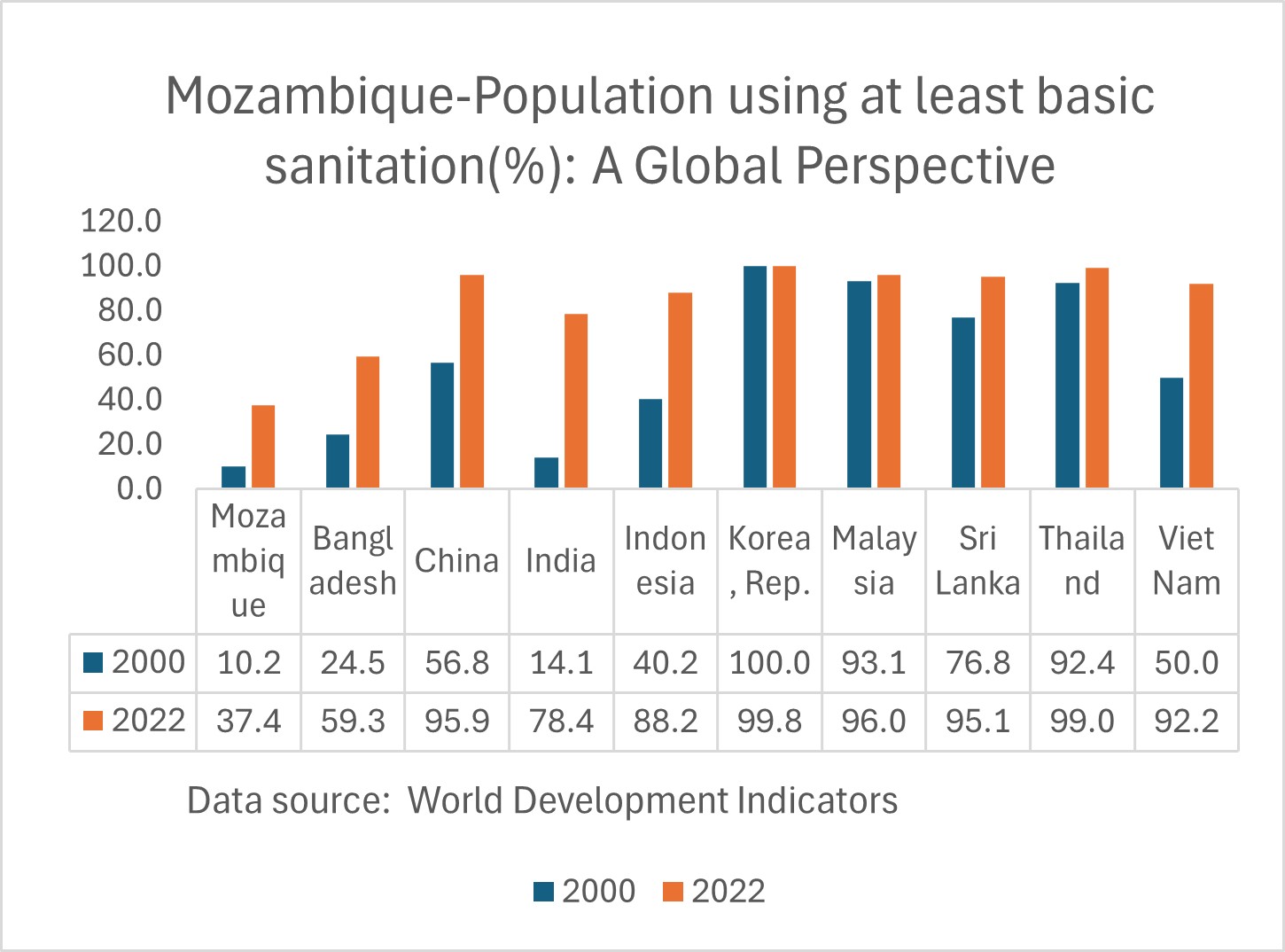
Mozambique – Proportion of rural population served with at least basic sanitation: A Global Perspective
In 2022, nearly 16 million people in rural Mozambique, representing about 77 percent of this population, lacked access to basic sanitation facilities, starkly contrasting with Vietnam, Sri Lanka, and Thailand, where the figures were 12 percent, 5 percent, and 2 percent respectively. This absence of safe sanitation is not just a pressing issue but a dire reality that demands urgent action. Access to safe sanitation is an inherent human right that everyone deserves without exception. Therefore, we must unite in solidarity to advocate for this essential right across Sub-Saharan Africa, where the need is critical and the potential for transformative community change is vital for the dignity and welfare of all individuals.
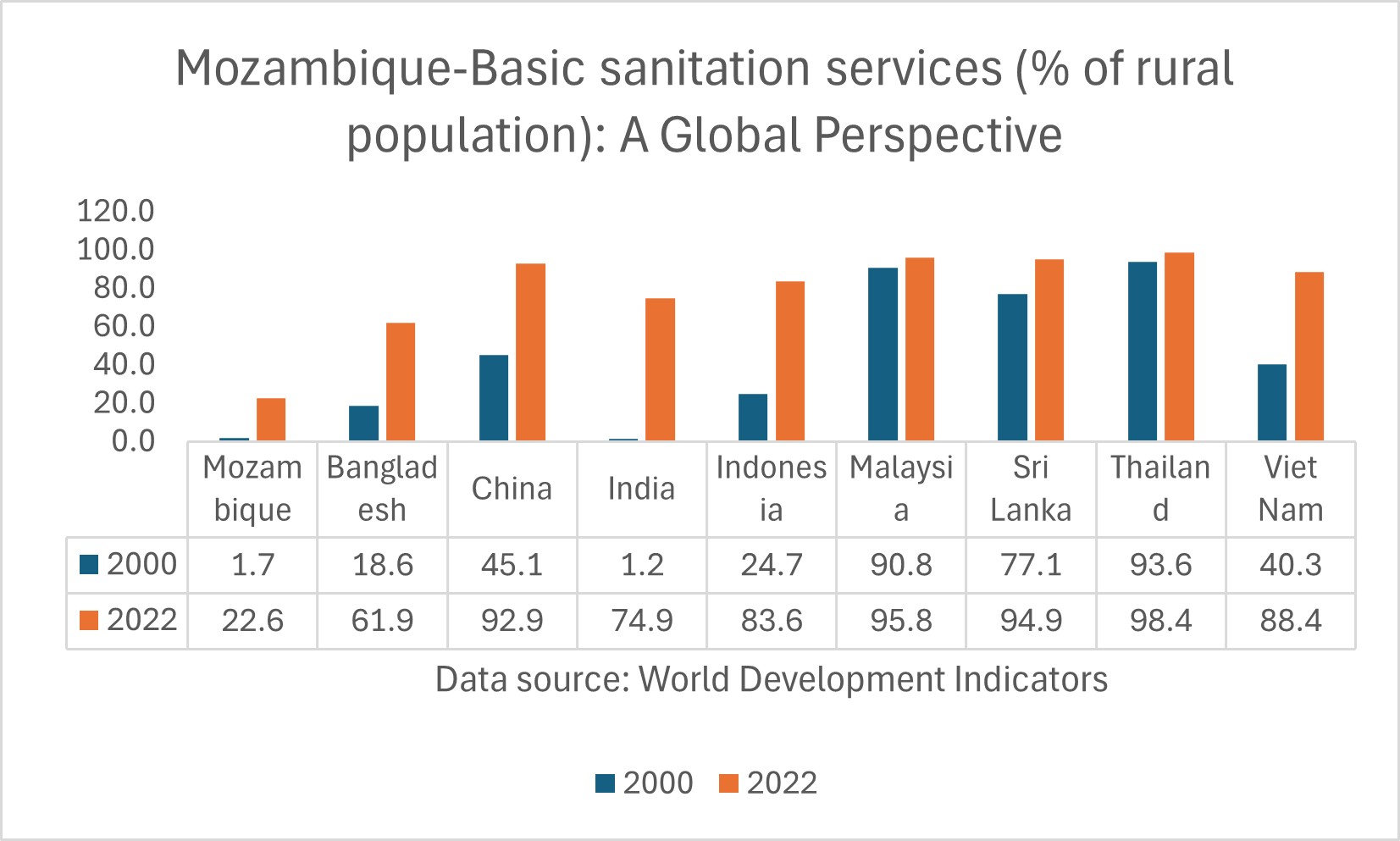
Mozambique-Water Supply
Mozambique- Proportion of total population served with at least basic drinking water
In 2022, proportion of population served with at least basic water for Mozambique was 63.2 %. Proportion of population served with at least basic drinking water of Mozambique increased from 22.7 % in 2000 to 63.2 % in 2022 an absolute change of 40.5 pp between 2000 and 2022.
Mozambique – Proportion of urban population served with at least basic drinking water
In 2022, proportion of urban population served with at least basic water for Mozambique was 87.3 %. Proportion of urban population served with at least basic drinking water of Mozambique increased from 61.1 % in 2000 to 87.3 % in 2022 an absolute change of 26.2 pp between 2000 and 2022.
Mozambique – Proportion of rural population with at least basic drinking water
In 2022, proportion of rural population served with at least basic water for Mozambique was 48.3 %. Proportion of rural population served with at least basic drinking water of Mozambique increased from 6.9% in 2000 to 48.3 % in 2022 an absolute change of 41.4 pp between 2000 and 2022.
Mozambique- Proportion of population not served with at least basic drinking water: A Global Perspective
Access to safe drinking water is a fundamental human right that demands urgent action. In Mozambique, nearly 9 million people, or about 27 percent of the population, lacked this essential resource, highlighting a serious public health crisis that calls for our attention. In contrast, 100 percent and 98 percent of the populations of the population in Thailand and Bangladesh enjoyed reliable access, respectively in 2022, revealing troubling global inequalities. This disparity stresses the urgent need for transformative actions in Sub-Saharan Africa, where many still lack vital resources necessary for a better quality of life. We must intensify our collective efforts to bridge this gap and ensure that everyone can access safe drinking water in communities across Sub-Saharan Africa.
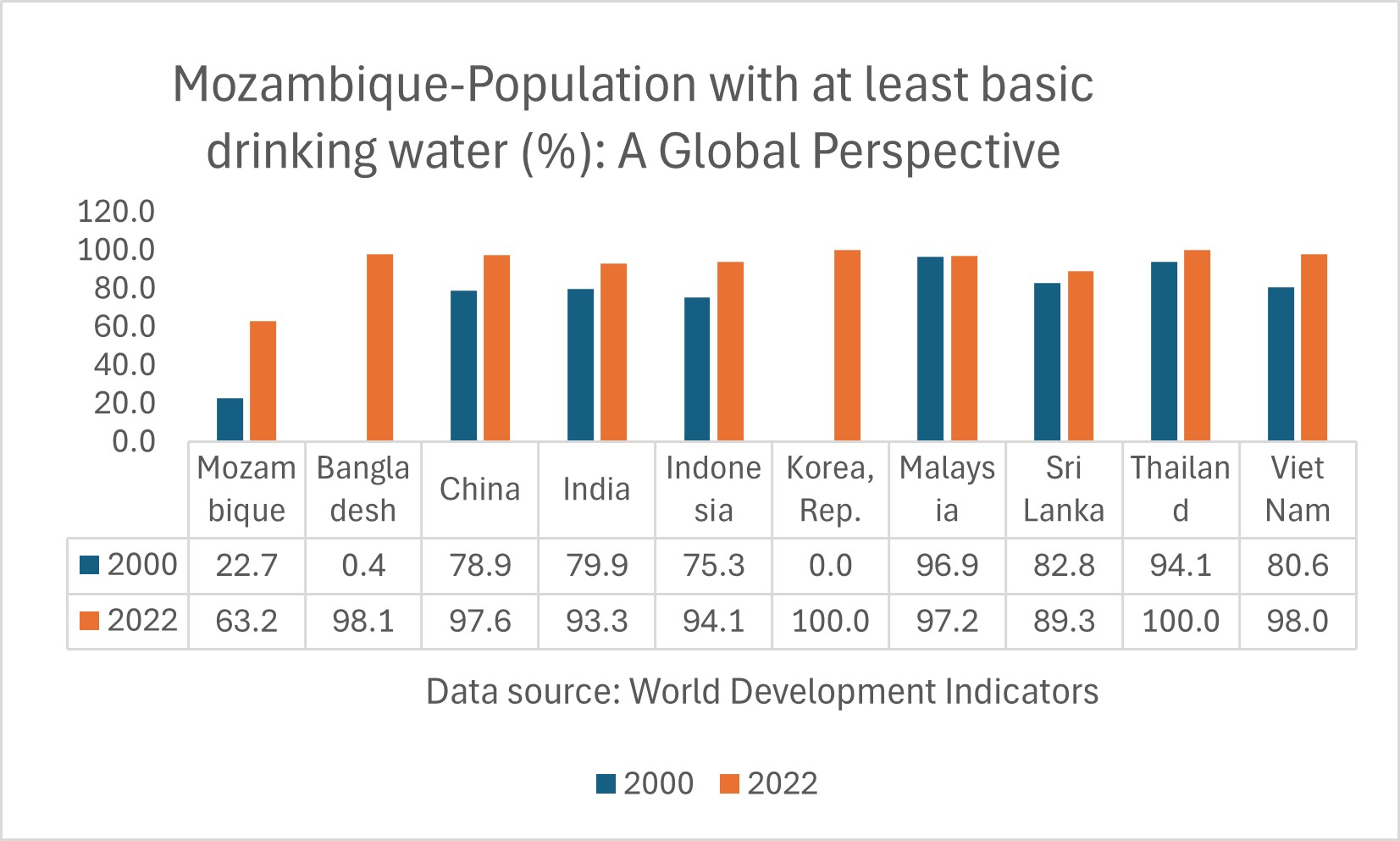
Mozambique- Proportion of rural population not served with at least basic drinking water: A Global Perspective
In 2022, it is alarming that 52 percent of Mozambique’s rural population, around 9 million people, lacked access to safe drinking water, highlighting a critical humanitarian crisis that requires our immediate action. In contrast, countries like Thailand, Bangladesh, and Vietnam reported 100 percent, 98 percent, and 97 percent access to safe drinking water, respectively, during the same period. This disparity not only reflects the governance challenges faced by many Sub-Saharan African nations but also emphasizes the need for collective efforts to improve living conditions and ensure equitable access to vital resources for the vulnerable populations across Sub-Saharan Africa.

Mozambique-Access to Electricity
Mozambique-Access to electricity (% of population)
In 2022, proportion of population with access to electricity for Mozambique was 33.2 % in 2022. The proportion of population with access to electricity of Mozambique increased from 6.1% in 2000 to 33.2% in 2022, an absolute change of 27.1 pp between 2000 and 2022.
Mozambique-Access to electricity (% urban population)
In 2022, proportion of urban population with access to electricity for Mozambique was 79.4%. The proportion of urban population with access to electricity of Mozambique increased from 23.3% % in 2000 to 79.4% in 2022, an absolute change of 56.1pp between 2000 and 2022.
Mozambique-Access to electricity (% of rural population)
In 2022, proportion of rural population with access to electricity for Mozambique was 5 %. The proportion of rural population with access to electricity of Mozambique increased from 1.4 % in 2010 to 5% in 2022, an absolute change of 3.6 pp between 2010 and 2022.
Mozambique- Proportion of population served with electricity: A Global Perspective
In 2022, almost 67 percent of people in Mozambique lived without electricity, highlighting a serious crisis that affects over 22 million individuals who lack this vital service needed for daily life. This troubling situation stands in stark contrast to countries like Vietnam, Thailand, Sri Lanka, and Malaysia, where universal electricity access has helped boost economic growth and enhance the quality of life for citizens. This situation emphasizes the urgent need for reforms in Sub-Saharan Africa to improve living standards and ensure everyone has the chance to succeed. The absence of reliable electricity goes beyond just inconvenience; it poses significant risks to development, health, and education while greatly hindering economic opportunities.
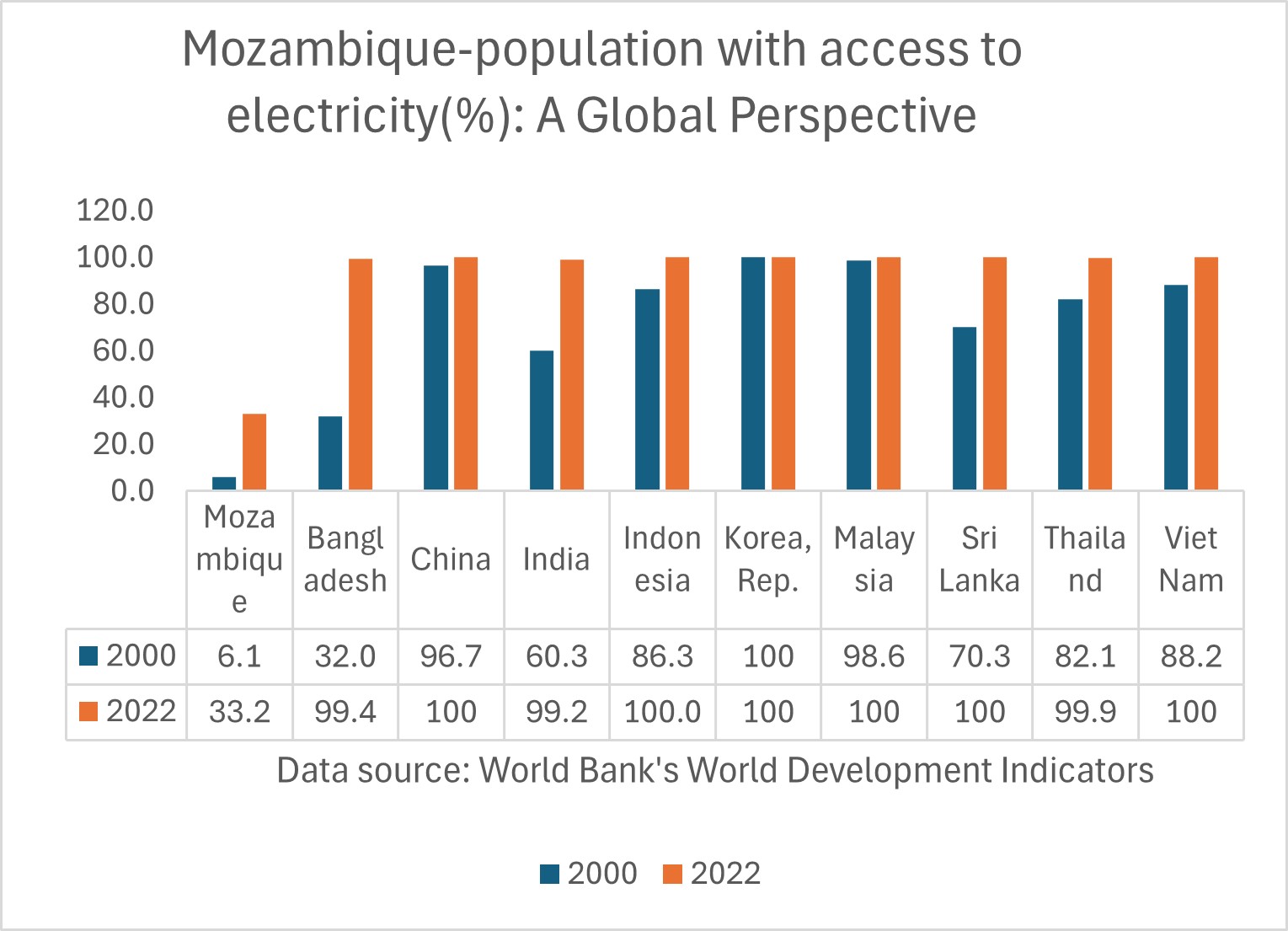
Mozambique- Proportion of rural population served with electricity: A Global Perspective
In 2022, an alarming 95 percent of Mozambique’s rural population, over 19 million people, lived without electricity, highlighting the urgent need for transformative change compared to nations like Vietnam, Thailand, and Sri Lanka, where every rural resident has reliable access to this essential utility. In countries like India and Bangladesh, 99 percent of rural populations enjoy dependable electricity in their daily lives. These striking statistics call for significant governance reforms across Sub-Saharan Africa and emphasize the necessity of ensuring every community has access to reliable electricity, fostering growth, innovation, and meaningful contributions to a sustainable and prosperous future for all.
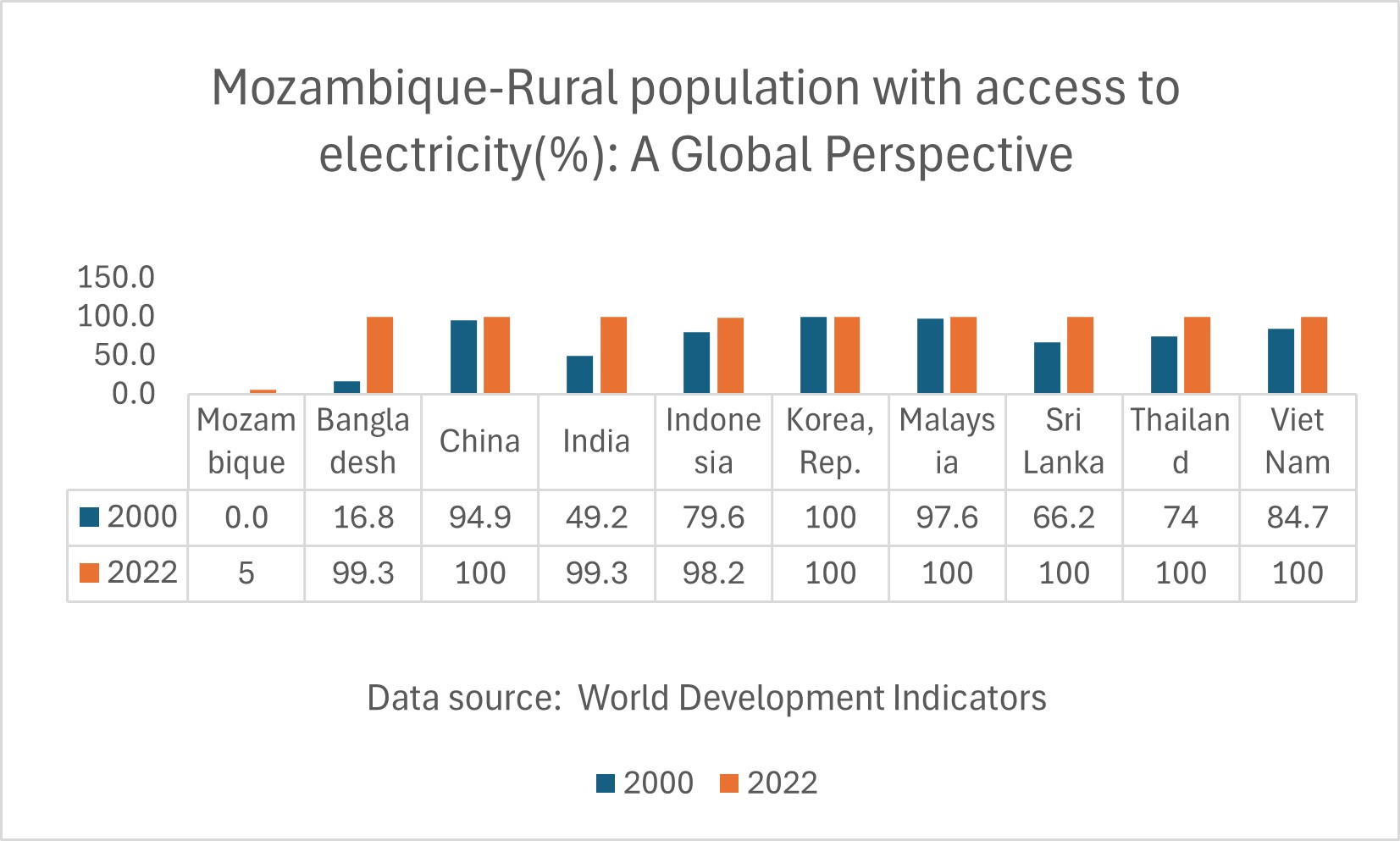
Mozambique: Health outcomes
Mozambique-Life expectancy: A Global Perspective
Examining life expectancy trends over the past seventy years reveals significant advancements that have allowed many to lead longer and healthier lives, yet deep disparities remain, especially in Sub-Saharan Africa. While the global average life expectancy for newborns rose from 47 years in 1950 to 71 years by 2021, progress in several Sub-Saharan African countries is still alarmingly limited. In Mozambique, life expectancy increased from 41 years in 1960 to 60 years in 2022, reflecting ongoing hardships. In contrast, countries like South Korea have seen life expectancy soar from 54 years in 1960 to 83 years in 2022, and the Maldives has improved from 39 years in 1960 to 81 years in 2022. The persistently low life expectancy in many Sub-Saharan African nations highlights the urgent challenges they face, including chronic poverty and inadequate healthcare systems, underscoring the critical need for compassionate actions to create a more equitable future.
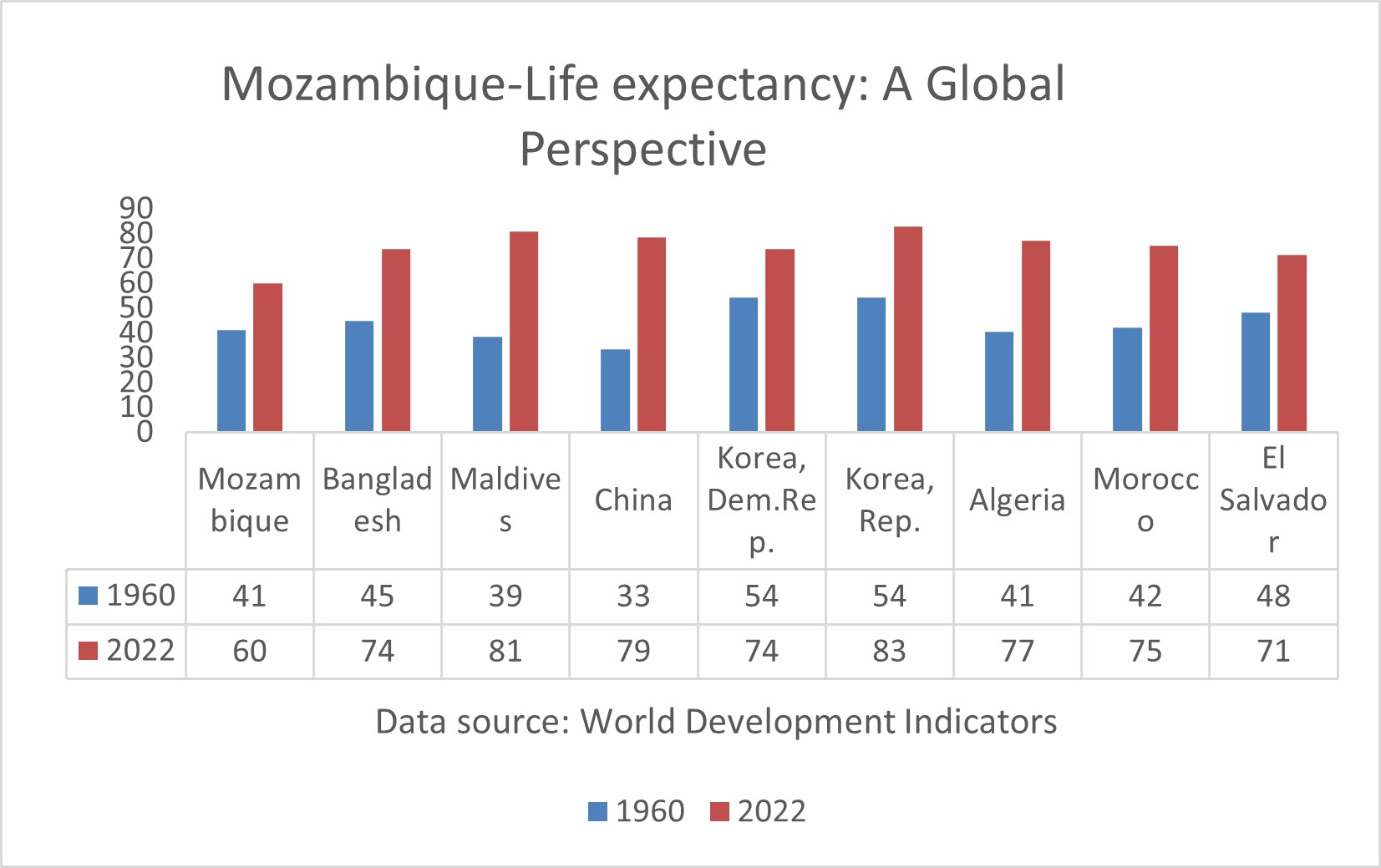

Mozambique-Mortality rate, under-5 (per 1,000 live births): A Global Perspective
Mozambique’s progress in reducing under-five mortality exemplifies the remarkable impact of collective efforts and community dedication. Since 1950, child mortality rates have declined significantly due to better living standards, improved healthcare access, enhanced nutrition, and safe drinking water. While affluent countries in Europe and America report rates below four percent, Mozambique has reduced its under-five mortality rate from 265 in 1980 to 66 in 2022. In contrast, Bangladesh and India have made impressive reductions from 206 and 169 in 1980 to just 29 in 2022. These figures highlight resilience and optimism amid the challenges facing healthcare in Sub-Saharan Africa and reinforce that improving health outcomes for vulnerable populations is both essential and achievable through effective governance and international cooperation. It is our shared responsibility to support sustainable initiatives that enhance the health and well-being of all.
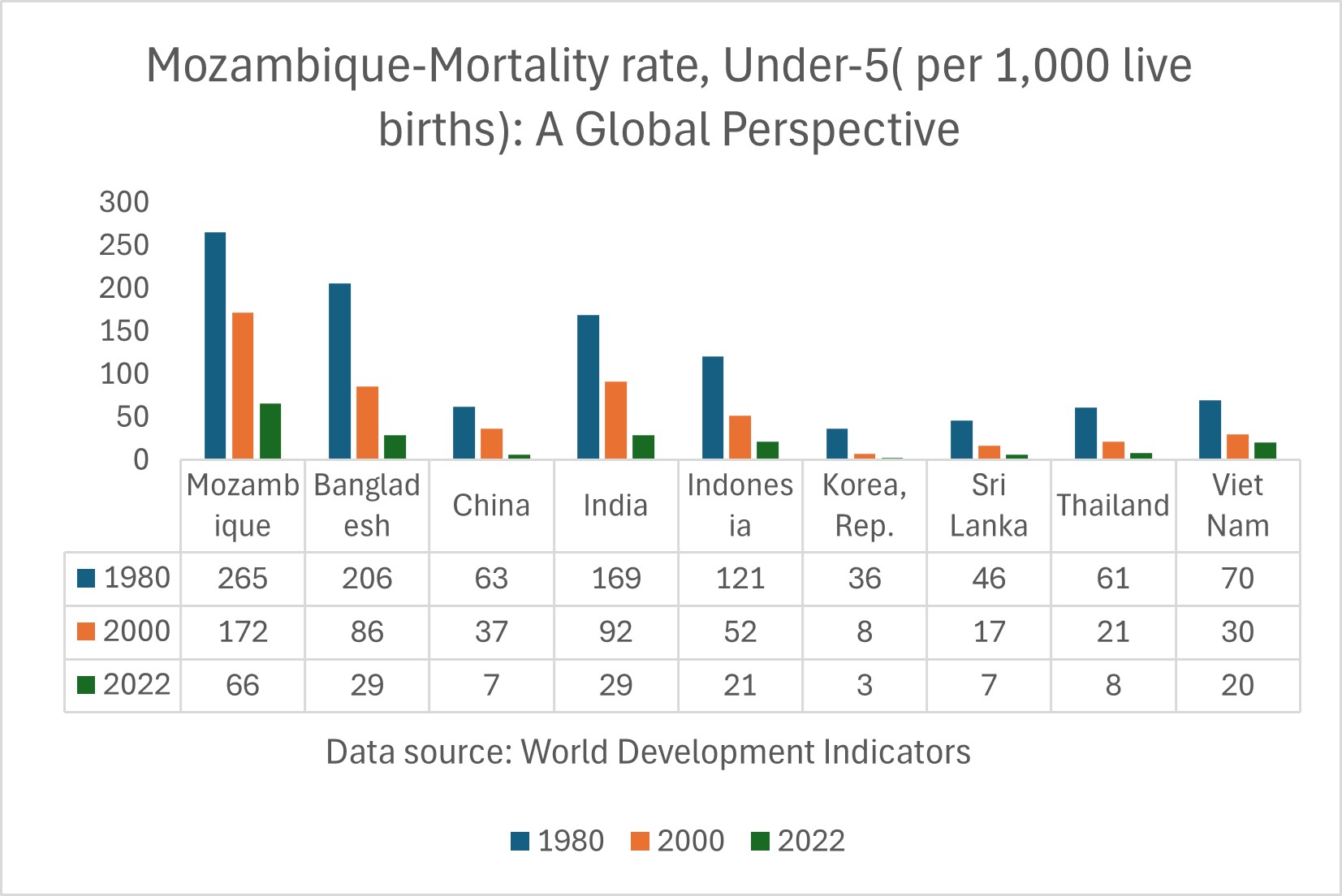
Mozambique-Maternal mortality ratio (per 100,000 live births): A Global Perspective
Mozambique has made significant strides in lowering its maternal mortality ratio from 532 in 2000 to 127 in 2020; however, this number remains unacceptably high and underscores the persistent challenges mothers encounter throughout the country. In comparison, countries such as Bangladesh, India, and Vietnam reported rates of 123, 103, and 46 in 2022, respectively. These troubling figures illuminate the ongoing crisis of pregnancy-related deaths in Mozambique, further complicated by a high birth rate and unresolved maternal health issues that require immediate attention. The data reveal critical deficiencies in the healthcare system and highlight the widespread underfunding affecting numerous Sub-Saharan African nations. The disparities in maternal health outcomes underscore the urgent necessity for increased investments in health infrastructure and resources, as the well-being of mothers and their children in Mozambique remains precarious and demands a united response.
